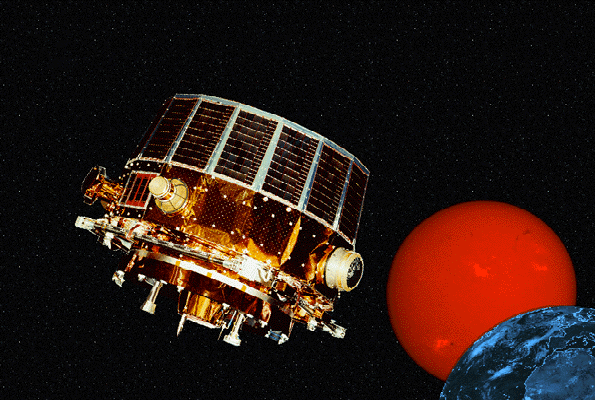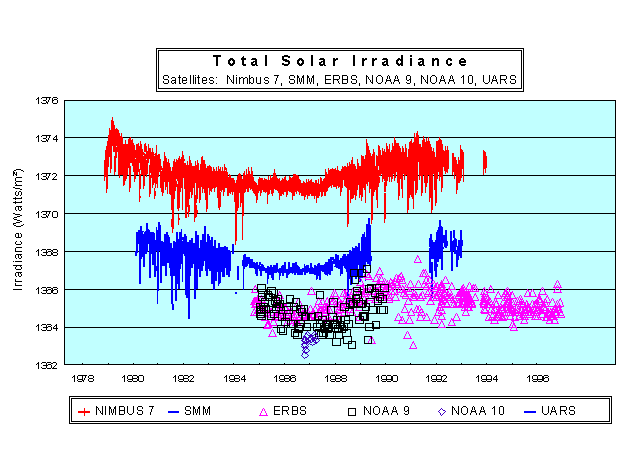
 |
|
News Page |

June 1999 |
This month's news stories:Equator-S Science MeetingIntergovernmental Panel on Climate Change |
 SPAT Participate in Equator-S Workshop
SPAT Participate in Equator-S WorkshopA meeting of the Equator-S Science Working Team took place at the end of May in Durham, New Hampshire, at which Imperial College was represented by Malcolm Dunlop and Elizabeth Lucek. The activity at the meeting showed that despite spacecraft problems and a prematurely short lifetime, a number of significant new scientific results have already been found with the limited data set. The Equator-S spacecraft, pictured on the right, was launched by an Ariane 4 rocket from Kourou, French Guiana, on December 2nd 1997 into a near equatorial orbit around the Earth. The magnetometer instrument on the spacecraft runs off a power supply which was designed and built at Imperial College.
The results from Equator-S include new information about the structure of the Earth's magnetosphere and magnetosheath, particularly on the dawnside and in the near magnetotail; the regions covered by the Equator-S orbit. The uniquely high time resolution of the spacecraft instrumentation has allowed particular phenomena associated with these regions to be examined in detail: transport of plasma species across an extended boundary layer signature at the magnetopause has been identified and high frequency Lion Roar signatures have been directly observed for the first time in the magnetic field data.
A special issue of Annales Geophysicae is likely to contain in excess of fifteen science papers, contributed by the instrument teams. The group at Imperial College has led or contributed to three of these papers, in collaboration with scientists at the Max-Planck-Institut für Extraterrestrische Physik (MPE) and the Institut für Geophysik und Meteorologie, Technische Universität Braunschweig. Study of the magnetic field data has so far concentrated on the passes made by the satellite through the magnetopause and magnetosheath on the dawn-side of the Earth. A paper (PDF preprint available) surveying the magnetopause crossings is in press in J. Geophys. Res. The crossings show extremely well ordered configurations over a large range of solar wind conditions. Traversals into or out of the magnetosheath are generally slow and therefore show detailed structure in the boundary. The Equator-S magnetic field data are rich in mirror-like wave activity in the magnetosheath which often continues to within a minute or so of the magnetopause. Closer to local noon, a plasma depletion layer (PDL), or magnetosheath transition layer, typically forms adjacent to the magnetopause. Previous spacecraft in this region have observed the PDL to extend for approximately 10 minutes to half an hour ahead of the magnetopause crossing. The Equator-S results suggest that during these orbits the plasma depletion layer is either of limited extent, or absent. One event showing intense mirror modes benefits from a close conjunction with the Geotail spacecraft and is being studied in detail. Another special high pressure event is the subject of joint study and exhibits both PDL and mirror characteristics adjacent to two separate magnetopause encounters in the same pass.
The Equator-S mission was made possible through support by the German Space Agency and forms part of the Inter-Agency Solar-Terrestrial Physics (ISTP) programme.
Malcolm Dunlop & Elizabeth Lucek 3rd June 1999

An international group of scientists met at Imperial College in April to work on a report being prepared for the Intergovernmental Panel on Climate Change (IPCC). The IPCC was set up by the United Nations Environment Programme and the World Meteorological Organisation to provide an authoritative international statement of scientific opinion on climate change. To date IPCC has produced two assessment reports, on the causes, impacts and possible response strategies to climate change, which are acknowledged as standard scientific references for all concerned with this topic in government, industry and academia worldwide.
A Third Assessment Report (TAR) is now being prepared and Jo Haigh of SPAT is a Lead Author of the chapter on Radiative Forcing of Climate. On April 14-16 the group of authors of this chapter met at SPAT to work on their first draft. After some editing this will be sent out for extensive review by international experts and the TAR is due for publication early in 2001. Jo Haigh's main contribution will be in assessing the role of the Sun in climate variability. The figure on the right (from the National Geophysical Data Center , USA) shows measurements of total solar irradiance made from several different satellites since 1979. (Click here or on the figure to see a full size, easier to read version.) It illustrates firstly that the value of the solar "constant" is not known to better than about 6 W/m2 but secondly that there is a clear modulation of about 1.5 W/m2 over the solar 11-year activity cycle. Recent work in SPAT using an atmospheric general circulation model has suggested solar variability may have a detectable effect on climate on decadal timescales but that it is unlikely to be the cause of the recent global warming trend.
Jo Haigh 7th June 1999
View last month's news, older news or return to Space and Atmospheric Physics home page